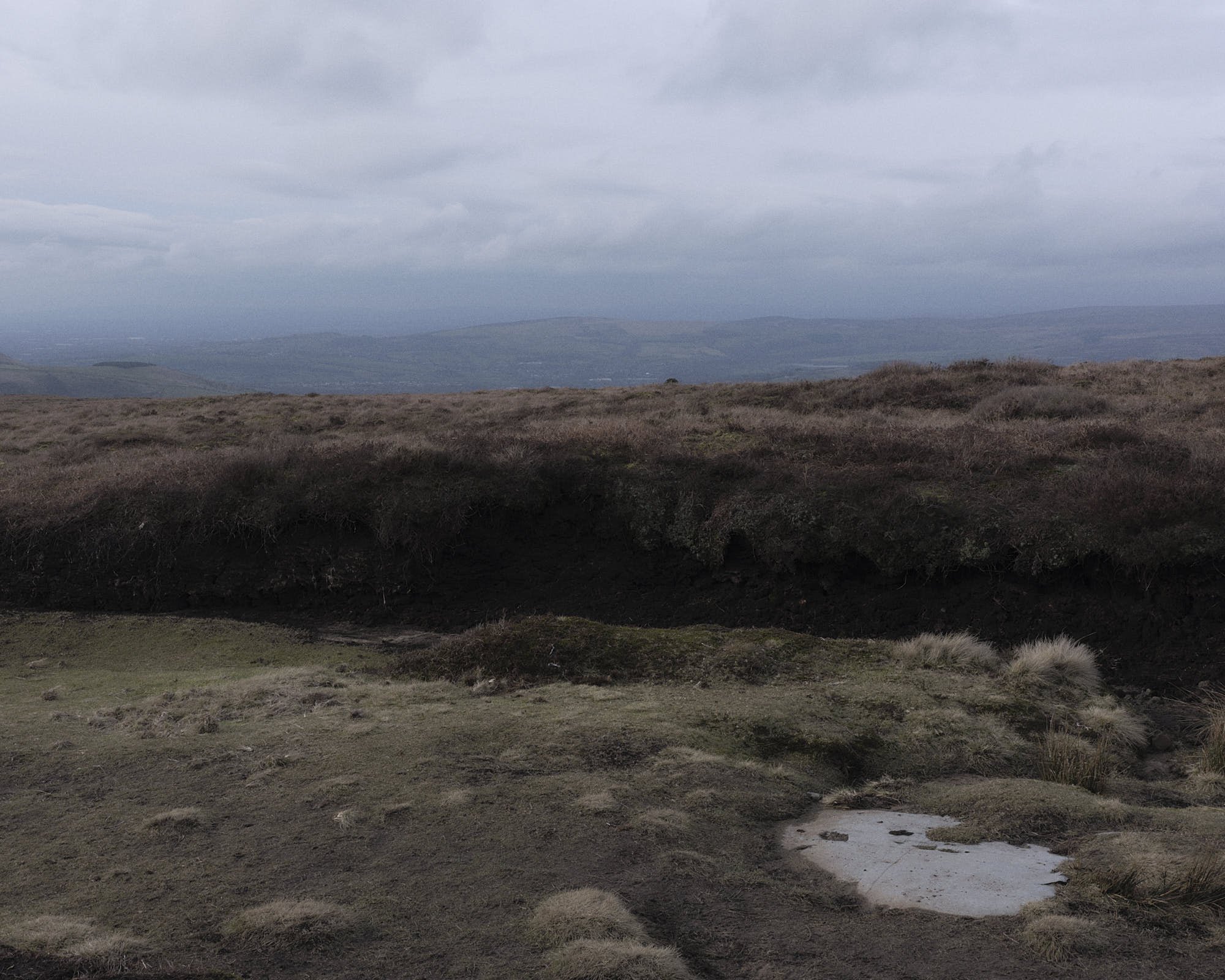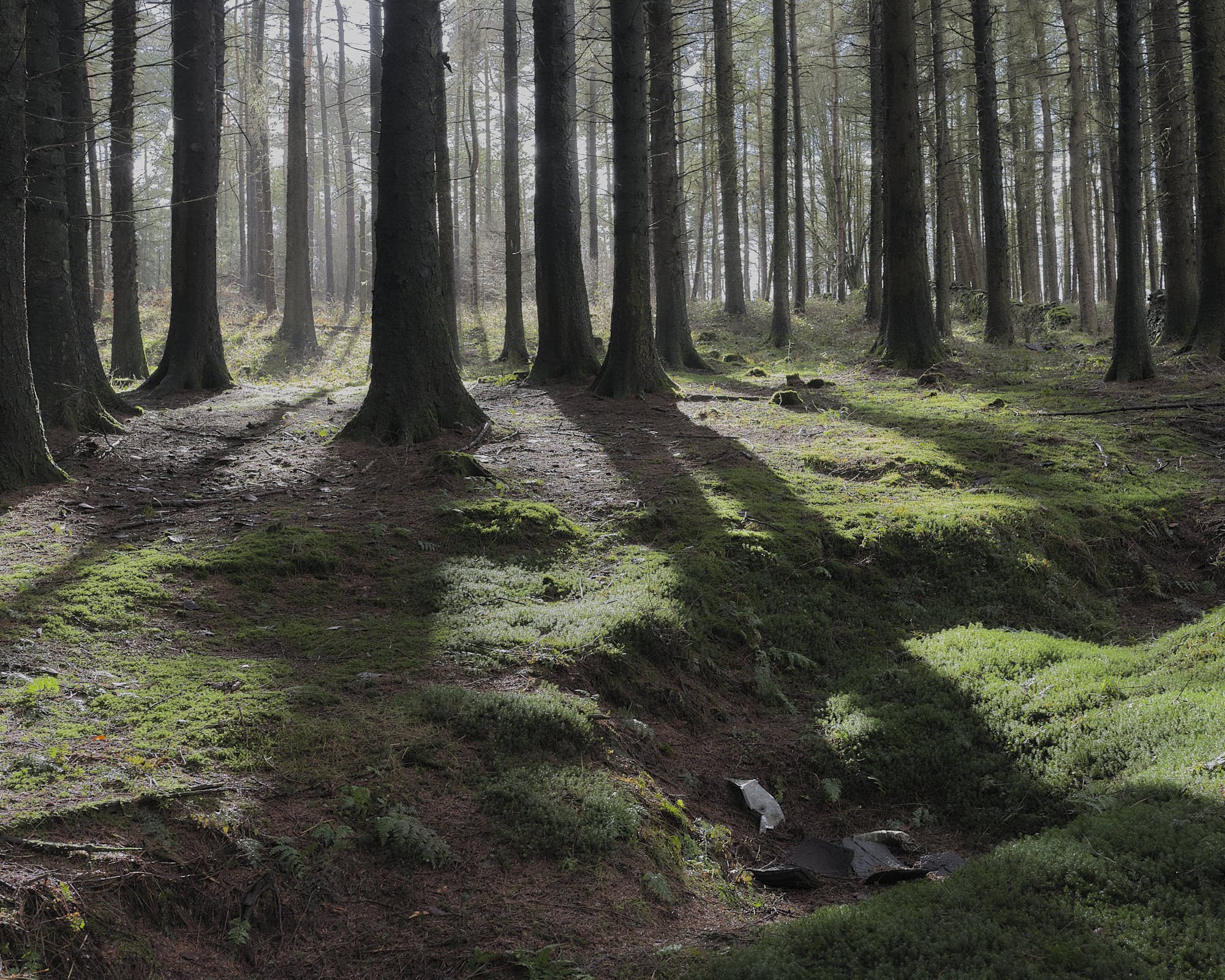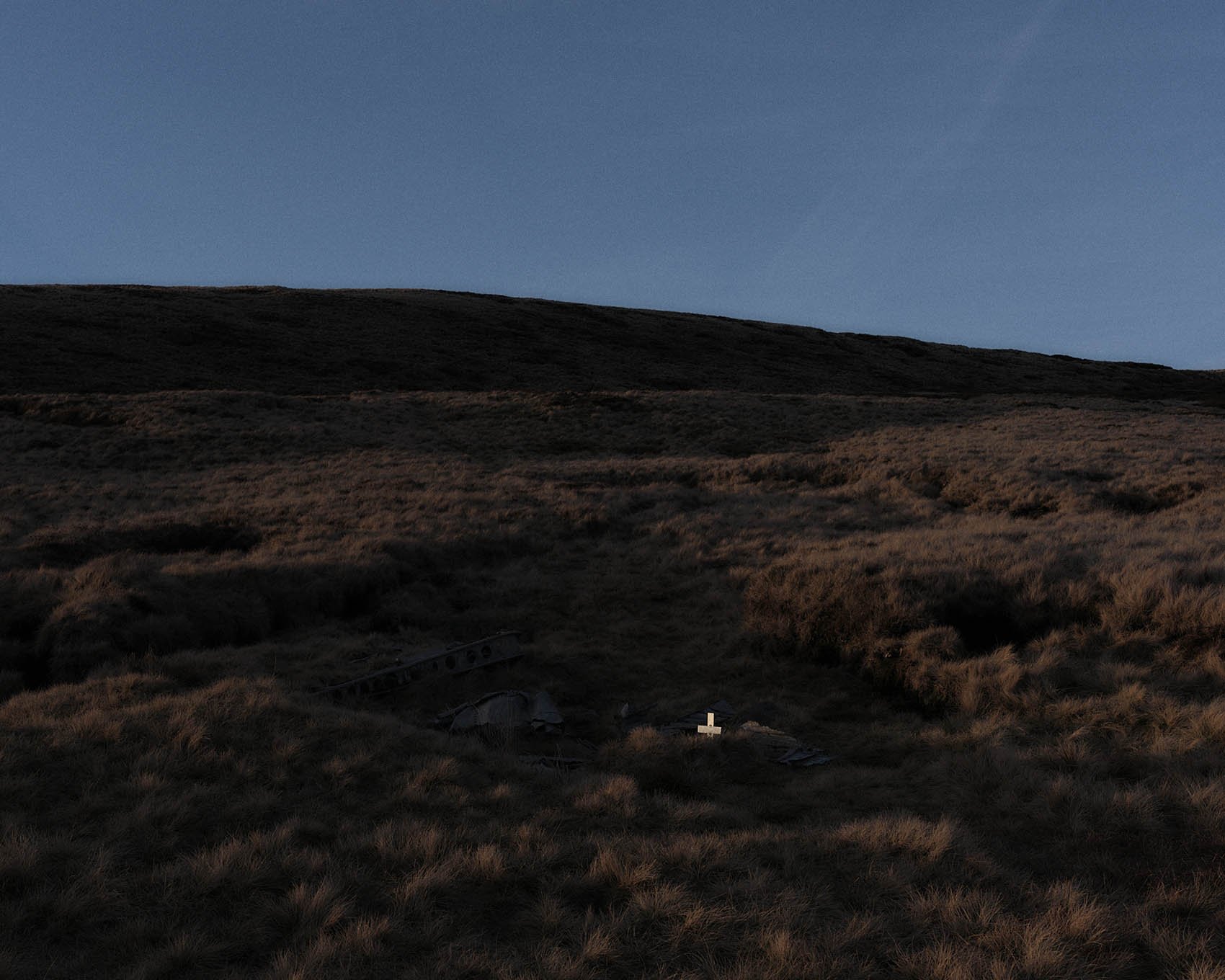Fallen
Fallen explores the traces of WW2 aviation events within the landscape of the Dark Peak, England: the fragments of a Meteor jet lying in the woods; a crater left by a flying bomb; the wreckage of a Flying Fortress lying in an icy landscape.
Behind the wreckage lie human stories of tragedies and lucky escapes of aircrew returning from missions or on training flights. At even the most remote sites there is a wooden cross; a poppy wired to a wing; a plaque or a flag. Revealing the lengths that the British people will go to commemorate the fallen on this forbidding moorland.
Geographical Magazine, 2023




Higher Shelf Stones

Ashop Moor

Twizle Head Moss

Siddens Moss

Howden Moor

Mill Hill

Tintwhistle Knarr

Hagg Side

Broomhead Moor

Cluther Rocks

Sykes Moor

Crow Stone Edge

Shelf Moor

Round Hill

Shelf Stones
Notes on the photographs
Higher Shelf Stones
The United States Airforce Boeing RB-29A was part of the 16th Photographic Reconnaissance Squadron. It had previously been used to photograph nuclear testing at Bikini Atoll, including the dropping of an atomic bomb. he aircraft crashed near Higher Shelf Stones on Bleaklow during a routine daytime flight to the US Airforce Base in Warrington. It’s believed that the pilots thought they had passed the hills of Bleaklow, but due to low cloud cover their visibilty was obscured and the aircraft hit the ground a little over 2,000 feet above sea level.
Pilot Captain Landon P. Tanner
Co-Pilot; Captain Harry Stroud Engineer
Technical Sergeant Ralph Fields Navigator
Sergeant Charles Wilbanks Radio Operator
Sergeant Gene A Gartner, Radar Operator
Sergeant David Devere Moore, Radio Operator
Technical Sergeant Saul R. Banks
Sergeant Donald R. Abrogast
Sergeant Robert I. Doyle Private
First Class William M. Burrows
Corporal M. Franssen
Corporal George Ingram Photographic Advisor
Captain Howard Keel of the Motion Picture Unit
No survivors
Superfortress RB-29A 44-61999
November 3rd 1948
Ashop Moor
Apparently unaware of the steeply rising plateau directly in front of them. Flying Officer James Desmond Horne and Flight Lieutenant Alan Green flew their Sabre aircraft down through dense cloud at around 6pm. At least one of the aircraft hit the corner of the plateau and then both jets tumbled out of control, down from the plateau edge and onto the moor below. Their bodies and the wrecked aircraft were discovered three days later by a hill walker.
Flight Lieutenant Alan Green
Flying Officer James Desmond Horne
No survivors
F-86 Sabres XD707 and XD730
July 22nd 1954
Twizle Head Moss
While flying at 1,600ft in low visibility, the aircraft struck the northern edge of Twizle Head Moss above Holmfirth, the aircraft disintegrated over a short distance and caught fire. The centre section was completely gutted by the fire, and such was the severity of the blaze that Cpl Clarence Watson who was flying as a passenger was never found. S/Sgt Curtis Anderson had been thrown out of the aircraft when it crashed, and although very badly injured survived.
1st Lieutenant Elmer D. Pitsenbarger
Flight Officer James D. Nendel
Jack M. Bliss Flight Officer
Frank Cser Flight Officer
Technical Sergeant Presley E. Farris
Technical Sergeant Zoe W. Zwinge
Technical Sergeant Frank A. Villelli
Staff Sergeant Curtis Anderson
Corporal Charles T. Lowbald
Corporal Clarence S. Watson
One Survivor:
Staff Sergeant Curtis Anderson
B-24H Liberator 42-94841
9th October 1944
Siddens Moss
A flight of four Meteors from RAF Linton-on-Ouse near York were on a training exercise. The lead pair were Flight Lieutenant David Merryweather Leach and Flying Officer Tony Hauxwell. The exercise was called off due to dense cloud and all four turned back to base. Flt Lt Leach reported he could see what he thought was Leeds through a break in the cloud and began to descend with his wingman following close, while the other pair, led by Flying Officer Leslie Hayward, maintained their height. Hearing nothing from the lead pair after a few minutes, F/O Hayward radioed Flt Lt Leach but received no reply. Alas the town Flt Lt Leech thought was Leeds was probably Stockport, and instead of the low plain of North Yorkshire, the two jet fighters descended at speed and still in formation into the southern slopes of Black Hill.
Flying Officer Anthony Henry Hauxwell
Flight Lieutenant David Merryweather Leach
No survivors
Gloster Meteors WA791
12th April 1951
Howden Moor
V1 Flying bomb had been deployed by a Heinkel 111 and was on target for the industrial city of Manchester but dropped short impacting into Howden Moors.
V1 Flying bomb
December 24nd 1944
Mill Hill
The aircraft was being ferried from Burtonwood to Hardwick by a two man ferry crew. They climbed to an indicated altitude of 2800 feet. At approximately 10:45 while in cloud and moderate to severe turbulence Lt Houpt spotted a small gap in the cloud and saw the ground was only about 150 feet below him. He then applied full power and began to climb, but before they could gain any meaningful height the aircraft struck the ground on Mill Hill some 1.5 miles from the Grouse Inn between Hayfield and Glossop. The two men extricated themselves from the shattered cockpit and walked along one of the streams until they reached the Hayfield to Glossop road. A passing lorry driver stopped and picked them up and took them to a nearby pub where Lt Houpt telephoned Burtonwood to report the accident. They were then retrieved by an Ambulance from Burtonwood and their injuries were then treated. These were mainly cuts & bruises but Lt Houpt did suffer a broken jaw.
Survived:
2nd Lieutenant Creighton R. Houpt
Staff Sergeant Jerome M. Najvar
B-24J Liberator 42-52003
11th October 1944
Tintwhistle Knarr
The crew had taken off from RAF Lindholme near Doncaster during the night of the 20th December for a Night Familiarisation exercise, this was to have been largely local flying. At just after midnight on the 21st the aircraft was heard flying east over Tintwhistle in low cloud, followed by the sound of it crashing. The aircraft burst into flames and was more or less gutted by fire. One of the crewmen had survived the crash and was found alive by the first local residents to reach the crash site but he died shortly afterwards. The recorded details of the crash are very brief but they state that the aircraft was meant to remain in the area around Lindholme but had strayed too far towards the west without the pilot becoming aware. He had begun his let down procedure when the aircraft flew into the hill.
Flight Sergeant Jack Sherwood Thompson
Flight Lieutenant Peter Maurice Maskell
Flight Sergeant Robert Smith
Flight Sergeant Vincent Graham
Sergeant William Allen Love
Flight Lieutenant Thomas Lowerth Johnson
Flight Sergeant David William Henry Harris
No survivors
Lancaster bomber PA411
21 December 1948
Hagg Side
Sgt H Joseph Harrington found himself in low cloud, with a broken radio, depleted fuel and the hills somewhere beneath him, took his Meteor up to 5,000 feet and ejected. In doing so he did what did what so many others lost in the region had failed to do, and survived. The abandoned Meteor crashed into woods above Ladybower. These
fragments are all that remain.
Sgt H Joseph Harrington
Survived
Meteor RA487
8th December 1950
Broomhead Moor
Wallace Cubitt had taken off from RAF Coltishall in atrocious weather, bound for Blackpool and later was reported by Air Traffic Control at West Drayton as having disappeared from the radar over the South Pennines. Later wreckage was located East of Stainmoor Clough, but when the search teams arrived they could only find small metal pieces. The later investigation concluded that the aircraft had hit the ground in a steep dive at between 400 and 450 mph and due to the saturated and boggy ground had buried itself deep in the earth where it remains to this day.
Pilot Wallace Cubitt
No survivors
Hawker Hunter T. Mk.7
11th June 1993
Sykes Moor
The crew had taken off from Church Fenton to carryout a local flying exercise, both of the crew where fairly new to the Squadron and Church Fenton so were familiarising themselves with the surrounding area. P/O Stanley Robinson had been awarded his wings 19 months earlier in June 1937 and had flown for a total of 300 hours. The aircraft failed to return from the exercise and was reported missing, it was on the 12th February 1939 a full two weeks since the aircraft disappeared, that the wreck was discovered by a member of a local walking club who was trying to catch up with his party. The aircraft had dived into the ground killing both crew instantly. In 1991 the memorial shown in the photo below was placed at the site.
Pilot Officer Stanley John Daly Robinson
Acting Pilot Officer Jack Elliott Thomas
No survivors
Blenheim Mk.I L1476
30th January 1939
Crow Stone Edge
En-route to Iceland the crew of theOxford Mk.I aircraft became disorientated in cloud and flew into high ground.
Pilot Pall Magnusson
Wireless Operator Alexander Watson
Passenger Johann Rist
No survivors.
Oxford Mk.I HN471
April 12th 1951
Cluther Rocks
The crew of AE381 were on a training flight from Skellingthorpe near Lincoln in weather not fit for flying, with high winds and blinding snow. After becoming lost on a night cross country navigation exercise the crew made radio contact with Ringway. They had over flown the airfield along the line of a now disused runway but had not been able to see anything due the snow and darkness, a radio message was sent to the pilot instructing him to turn through 180o to make another pass over the airfield, before this turn could be executed the aircraft flew into the western edge of Kinder where it burst into flames and was totally destroyed.
Sergeant RAAF Royal George Heron
Sergeant Walter Chantler Williams
Sergeant William Thomas Tromans
Sergeant Sydney Albert Peters
No survivors
Handley Page Hampden Mk.I AE381
21st January 1942
Shelf Moor
The aircraft was being flown on a transport flight from airfield B.44 at Poix, to the SW of Amiens, in France to Renfrew. It had stopped at Leicester East and took off from there during the morning of the 24th July and failed to arrive at its destination. On the 26th July the wreckage was discovered by a member of the RAF, who was on leave, when he and his girlfriend were walking on Bleaklow. The crash site was attended by the Mountain Rescue Team from No.28 MU at Hapur Hill and initially they struggled to track down the parent unit of the crew to report the crash to. The USAAF accident report recorded that the crash probably occurred around 09:00 on the 24th while the aircraft was flying in cloud, which at the time varied between 500 and 1,500ft.
Lieutenant George L. Johnson
First Lieutenant Earl W. Burns
First Lieutenant Beverly W. Izlar
Sergeant Theodore R. McCrocklin
Sergeant Francis M. Maloney
Corporal Grover R. Alexander
Leading Aircraftsman J. D. Main
C-47A Dakota
July 24th 1945
Round Hill
The aircraft was lost whilst on a ferry flight from Blackburn’s factory at Sherburn-in-Elmet near Leeds to Harwarden near Chester. The pilot was attempting to fly above the cloud which covered the hills and it is thought he was descending thinking that he had cleared the hills but a head wind may have slowed his progress and therefore meant he was still over the hills as he descended. The aircraft struck the moorland and the aircraft was destroyed.
First Officer Thomas William Rogers
No survivors
Botha Mk.I W5103
10th December 1941
Shelf Stones
The aircraft was flying from RAF Linton-on-Ouse and had earlier been carrying out bumps and circuits but the crew became tired of this and decided to fly around the local area. As it became dark the crew became disorientated and eventually ended up circling Glossop. The aircraft was observed flying into the hillside at 10:10pm. The demise of KB993 in May 18th 1945 was one of the first post World War 2 crashes on high ground, ten days after the end of hostilities. There was no navigator on board because the crew should have been carrying out only circuits, a task which he would have had no part in.
Flying Officer Anthony Arthur Clifford
Flying Officer Kenneth McIvor
Flying Officer David Fehrman
Warrant Officer Michael Cecil Cameron
Flight Sergeant Clarence Halvorson
Flight Sergeant Leslie Claude Hellekson
No survivors
Lancaster Mk.X KB993
18th May 1945